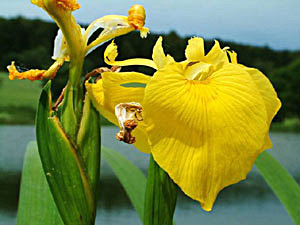
medicinal herbs
Yellow Flag
Iris pseudacorus

Herb: Yellow Flag
Latin name: Iris pseudacorus
Family: Iridaceae (Iris Family)
Medicinal use of Yellow Flag:
The fresh root is astringent, cathartic, emetic, emmenagogue and odontalgic. A slice of the root held against an aching tooth is said to bring immediate relief. It was at one time widely used as a powerful cathartic but is seldom used nowadays because of its extremely acrid nature. It can also cause violent vomiting and diarrhoea. When dried the root loses its acridity and then only acts as an astringent.Description of the plant:

Plant:
Perennial
Height:
150 cm(5 feet)

Flowering:
May toJuly

Scent:
ScentedPerennial
Habitat of the herb:
Damp marshy areas, swampy woods and in shallow water or wet ground on the edges of rivers and ditches. Often found in shady places.Edible parts of Yellow Flag:
The seed is said to make an excellent coffee substitute as long as it is well roasted. Caution is advised, it might be poisonous.Other uses of the herb:
A beautiful yellow dye is obtained from the flowers. A good black dye is obtained from the root if it is mixed with iron sulphate. It is brown otherwise. The root is a source of tannin and has been used in making ink. A delicately scented essential oil, obtained from the roots, has been used to adulterate the oil of Acorus calamus.Propagation of Yellow Flag:
Seed - best sown as soon as it is ripe in a cold frame. Stored seed should be sown as early in the year as possible in a cold frame. A period of cold stratification improves germination time and rates. Prick out the seedlings into individual pots when they are large enough to handle and grow them on in the greenhouse or cold frame for their first year. Plant out into their permanent positions in late spring or early summer. Division in March or October. Early autumn is best. Very easy, larger clumps can be replanted direct into their permanent positions, though it is best to pot up smaller clumps and grow them on in a cold frame until they are rooting well. Plant them out in the spring.Cultivation of the herb:
Damp marshy areas, swampy woods and in shallow water or wet ground on the edges of rivers and ditches. Often found in shady places.Known hazards of Iris pseudacorus:
The leaves, and especially the rhizomes, of this species contain an irritating resinous substance called irisin. If ingested this can cause severe gastric disturbances. Plants can cause skin irritations and allergies in some people.Plant information taken from the Plants For A Future.
